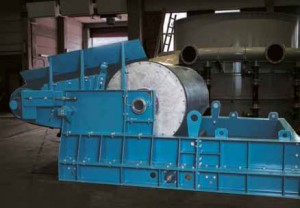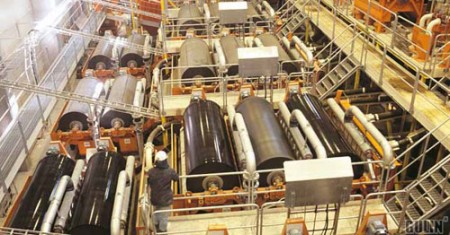Magnetic separation equipment has long been used to upgrade and beneficiate a wide variety of minerals(such as: iron ore) and materials. Over the years, significant advances in both wet and dry magnetic separators have improved their operability and separation performances, broadening their use. Through our unremitting efforts, traditional processing obstacles can be hurdled allowing for more efficient and robust minerals processing solutions.
Magnetic separation equipment
Magnetic separation equipment for minerals processing generally falls into three basic categories: low, medium and high intensity, based on the relative magnetic field strength employed to accomplish separation.
Low intensity magnetic separators
Low intensity magnetic separators are generally wet separators and are commonly used for concentration of magnetite, or for scalping of ferromagnetic materials. The Low intensity magnetic separators are high capacity units and simple to operate, so they serve these relatively straightforward applications well.
Medium intensity magnetic separators
Medium intensity magnetic separators are most commonly dry, rare earth based drum magnetic separators with common applications in highly paramagnetic mineral applications including ilmenite, chromite and garnet processing. This rare earth based drum magnetic separators designs, similar to low intensity magnetic separators, are robust and typically offer high capacity and simple operation. High intensity magnetic separators may be wet or dry.
High intensity dry magnetic separations
High intensity dry magnetic separations are carried out with induced-roll or rare-earth roll magnetic separators, though the latter is far more common. The rare earth based drum magnetic separator is known for efficient separations with weakly paramagnetic minerals, albeit it at somewhat lower capacity than low and medium intensity magnetic separators.
Rare earth based drum magnetic separators units are most commonly employed in cleaning zircon, silica sands and a variety of other industrial minerals. Wet, high intensity magnetic separators generate high field strengths and pass slurry through matrix arrangements to collect the magnetic fraction. Wet, high intensity magnetic separators are traditionally applied in mineral sands to collect ilmenite in the early stages of a flowsheet, and have a host of other common uses including iron ore (haematite) beneficiation.
Precautions for use
Dry magnetic separators suffer from temperature limitations, either because the rare-earth magnets suffer irreversible loss of magnetism at elevated temperatures, or because the materials used in electromagnets cannot withstand intense heat. Caution is taken in defining these limitations and to ensure process conditions are controlled to make certain magnetic separators will not be damaged by high feed temperature excursions. Typical temperature limits are 120–150 degrees Celsius, which, in some cases, does not allow for straightforward installations. Temperature management to enable dry magnetic separation can involve added costs if feed cooling is required, particularly in cases where downstream process operations require additional energy input to re-elevate the material temperature.



